Page 832 of 1333
Fig. 5: Symptom Check List - Page 4
INDIVIDUAL SYSTEM-BASED CHECK LISTS
NOTE: Have the service adviser fill out these forms with the
customer whenever possible.
Page 873 of 1333
Fig. 2: Diagnostic Fault Chart (2 of 2)
Courtesy of Mitsubishi Motor Sales of America.
DIAGNOSTIC PROCEDURE (USING DRB-II)
DRB-II PROCEDURE
NOTE: When using diagnostic code charts, DO NOT skip any steps in
chart or incorrect diagnosis may result. Always check related
Technical Service Bulletins (TSB's).
Refer to ENTERING ON-BOARD DIAGNOSTICS (USING DRB-II) to
retrieve fault codes. If fault codes are NOT present and/or DRB-II is
used, proceed to one of the following tests:
* Go to NO START TEST 1 (NS-1) chart if a no-start condition
exists or engine stalls after start-up. Perform indicated
VERIFICATION PROCEDURE chart after repairs. Ensure charts
apply to engine being tested.
* Go to DRIVEABILITY TEST 1 (DR-1) chart if engine runs but has
performance problems. Perform indicated VERIFICATION
Page 937 of 1333

that all of the engine control systems are operating as they were
designed to. Therefore, they are not the cause of the driveability
problem.
The following additional items can not be overlooked as possible
causes of a driveability problem.
1. THROTTLE VALVE AREA - Dirt or ice buildup causing rough idle and
stalling.
2. ENGINE IGNITION TIMING - Must be set with timing terminal
grounded.
3. ENGINE VACUUM - Must be normal for your altitude.
4. ENGINE VALVE TIMING - To specifications.
5. ENGINE COMPRESSION - To specifications.
6. ENGINE P.C.V. SYSTEM - Must flow freely.
7. ENGINE EXHAUST SYSTEM - Must be free of any restrictions.
8. POWER BRAKE BOOSTER - No internal vacuum leaks.
9. TORQUE CONVERTER CONDITION - May cause very low power at breakaway
or high speed (Only 1 condition at a time).
10. FUEL CONTAMINATION - High alcohol or water content.
11. FUEL INJECTORS - Rough idle may be caused by injector wiring not
connected to correct injector.
12. ENGINE SECONDARY IGNITION CHECK - Abnormal scope patterns.
13. TECHNICAL SERVICE BULLETINS - Any that apply to vehicle.
14. All air intake piping and vacuum hoses must be in place and
secure. The proper air filter element must be used.
15. FUEL PRESSURE - Must be correct.
Specification: With no vacuum at the regulator:
48 PSI on V6 & non-turbo 4 Cyl. engines
36 PSI on turbo engines
NS-1: TESTING IGNITION CIRCUIT - 1.6L
Fig. 75: Circuit Diagram NS-1 (1.6L)
Page 1016 of 1333
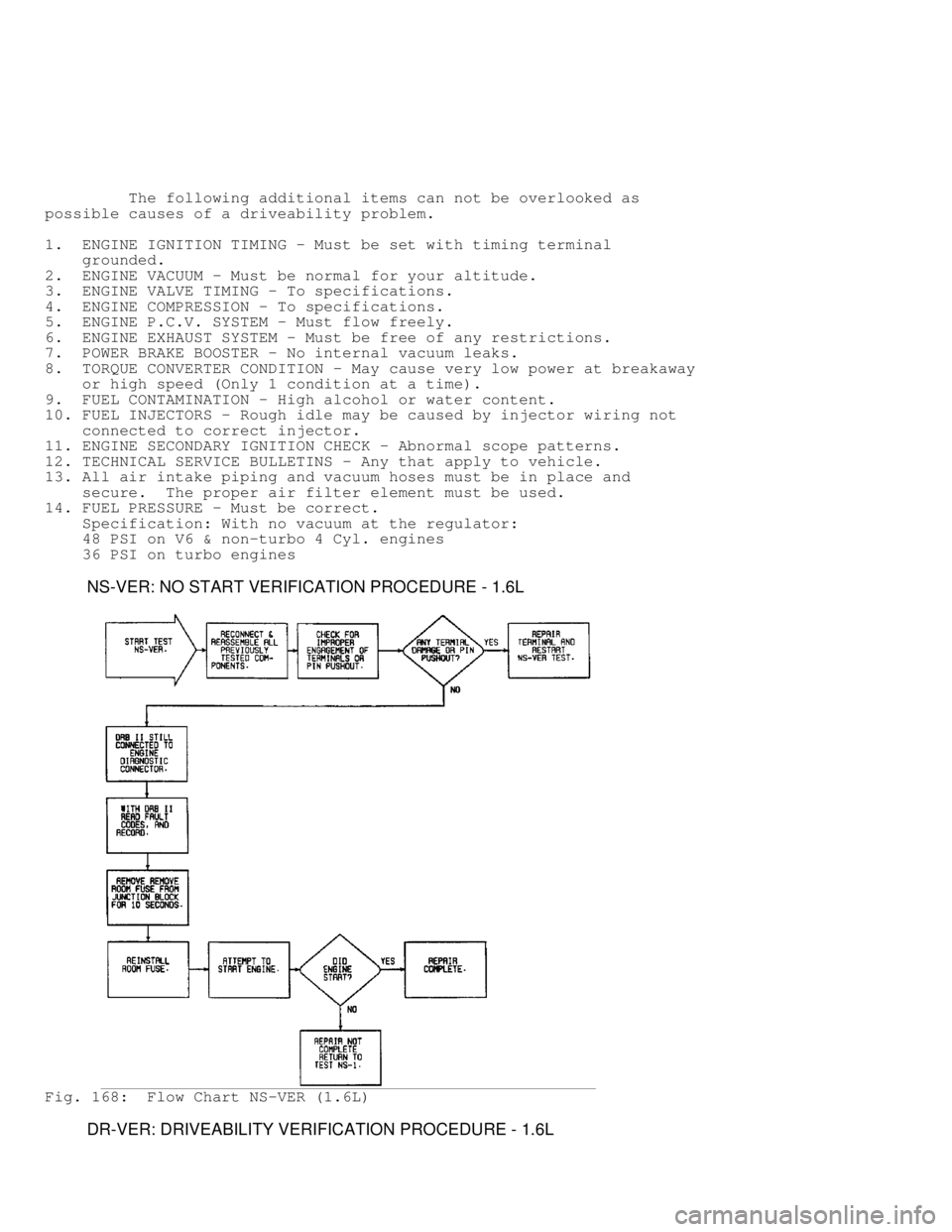
The following additional items can not be overlooked as
possible causes of a driveability problem.
1. ENGINE IGNITION TIMING - Must be set with timing terminal
grounded.
2. ENGINE VACUUM - Must be normal for your altitude.
3. ENGINE VALVE TIMING - To specifications.
4. ENGINE COMPRESSION - To specifications.
5. ENGINE P.C.V. SYSTEM - Must flow freely.
6. ENGINE EXHAUST SYSTEM - Must be free of any restrictions.
7. POWER BRAKE BOOSTER - No internal vacuum leaks.
8. TORQUE CONVERTER CONDITION - May cause very low power at breakaway
or high speed (Only 1 condition at a time).
9. FUEL CONTAMINATION - High alcohol or water content.
10. FUEL INJECTORS - Rough idle may be caused by injector wiring not
connected to correct injector.
11. ENGINE SECONDARY IGNITION CHECK - Abnormal scope patterns.
12. TECHNICAL SERVICE BULLETINS - Any that apply to vehicle.
13. All air intake piping and vacuum hoses must be in place and
secure. The proper air filter element must be used.
14. FUEL PRESSURE - Must be correct.
Specification: With no vacuum at the regulator:
48 PSI on V6 & non-turbo 4 Cyl. engines
36 PSI on turbo engines
NS-VER: NO START VERIFICATION PROCEDURE - 1.6L
Fig. 168: Flow Chart NS-VER (1.6L)
DR-VER: DRIVEABILITY VERIFICATION PROCEDURE - 1.6L
Page 1071 of 1333
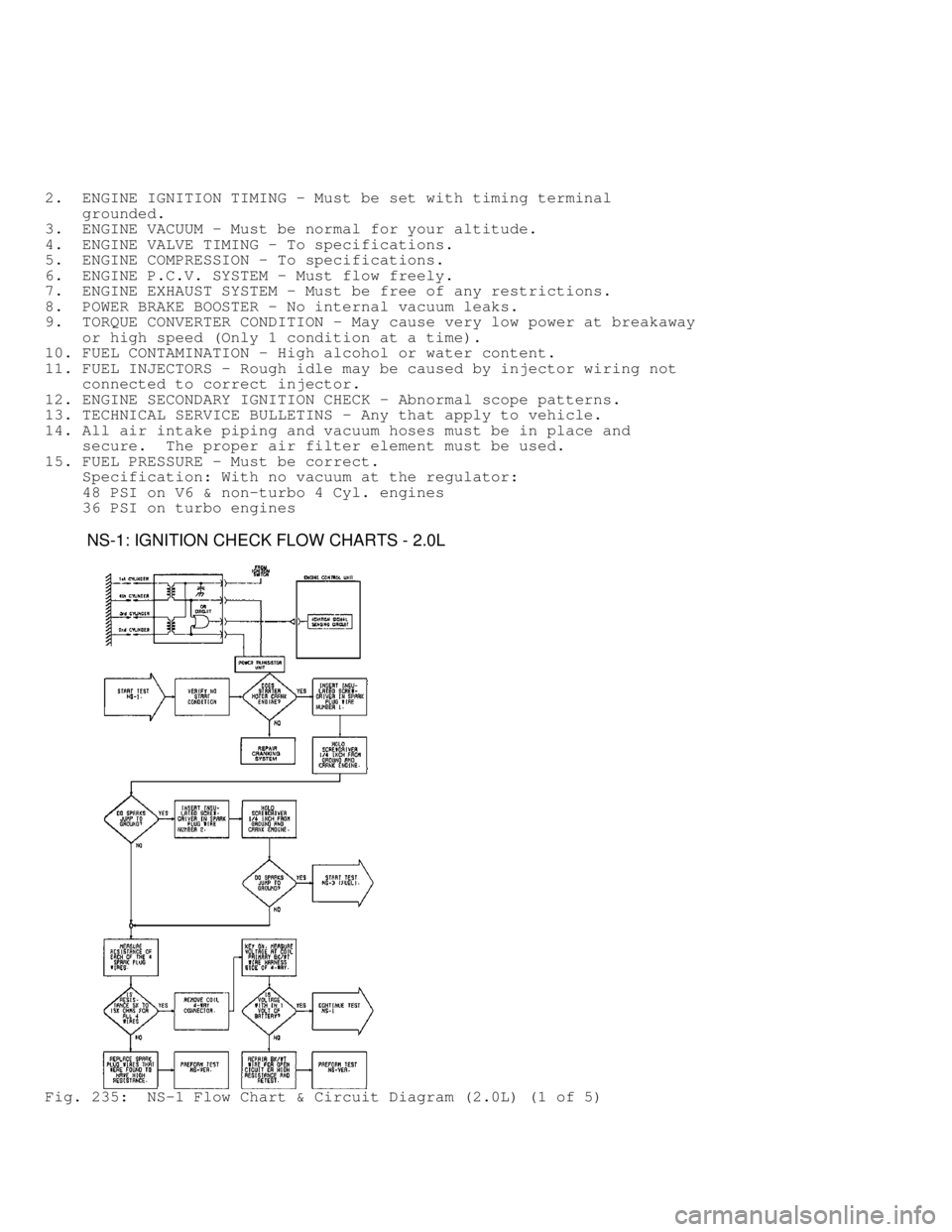
2. ENGINE IGNITION TIMING - Must be set with timing terminal
grounded.
3. ENGINE VACUUM - Must be normal for your altitude.
4. ENGINE VALVE TIMING - To specifications.
5. ENGINE COMPRESSION - To specifications.
6. ENGINE P.C.V. SYSTEM - Must flow freely.
7. ENGINE EXHAUST SYSTEM - Must be free of any restrictions.
8. POWER BRAKE BOOSTER - No internal vacuum leaks.
9. TORQUE CONVERTER CONDITION - May cause very low power at breakaway
or high speed (Only 1 condition at a time).
10. FUEL CONTAMINATION - High alcohol or water content.
11. FUEL INJECTORS - Rough idle may be caused by injector wiring not
connected to correct injector.
12. ENGINE SECONDARY IGNITION CHECK - Abnormal scope patterns.
13. TECHNICAL SERVICE BULLETINS - Any that apply to vehicle.
14. All air intake piping and vacuum hoses must be in place and
secure. The proper air filter element must be used.
15. FUEL PRESSURE - Must be correct.
Specification: With no vacuum at the regulator:
48 PSI on V6 & non-turbo 4 Cyl. engines
36 PSI on turbo engines
NS-1: IGNITION CHECK FLOW CHARTS - 2.0L
Fig. 235: NS-1 Flow Chart & Circuit Diagram (2.0L) (1 of 5)
Page 1136 of 1333
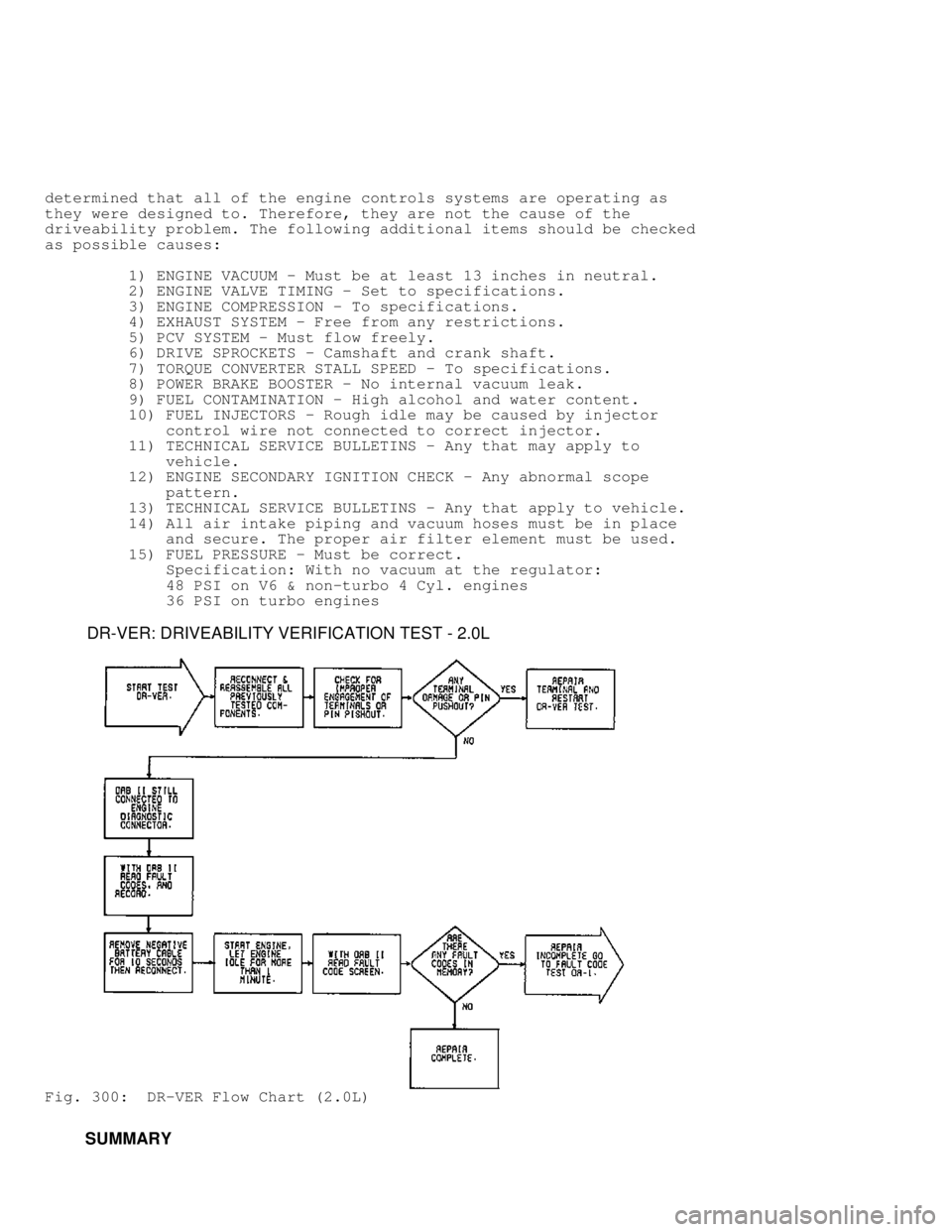
determined that all of the engine controls systems are operating as
they were designed to. Therefore, they are not the cause of the
driveability problem. The following additional items should be checked
as possible causes:
1) ENGINE VACUUM - Must be at least 13 inches in neutral.
2) ENGINE VALVE TIMING - Set to specifications.
3) ENGINE COMPRESSION - To specifications.
4) EXHAUST SYSTEM - Free from any restrictions.
5) PCV SYSTEM - Must flow freely.
6) DRIVE SPROCKETS - Camshaft and crank shaft.
7) TORQUE CONVERTER STALL SPEED - To specifications.
8) POWER BRAKE BOOSTER - No internal vacuum leak.
9) FUEL CONTAMINATION - High alcohol and water content.
10) FUEL INJECTORS - Rough idle may be caused by injector
control wire not connected to correct injector.
11) TECHNICAL SERVICE BULLETINS - Any that may apply to
vehicle.
12) ENGINE SECONDARY IGNITION CHECK - Any abnormal scope
pattern.
13) TECHNICAL SERVICE BULLETINS - Any that apply to vehicle.
14) All air intake piping and vacuum hoses must be in place
and secure. The proper air filter element must be used.
15) FUEL PRESSURE - Must be correct.
Specification: With no vacuum at the regulator:
48 PSI on V6 & non-turbo 4 Cyl. engines
36 PSI on turbo engines
DR-VER: DRIVEABILITY VERIFICATION TEST - 2.0L
Fig. 300: DR-VER Flow Chart (2.0L)
SUMMARY
Page 1149 of 1333
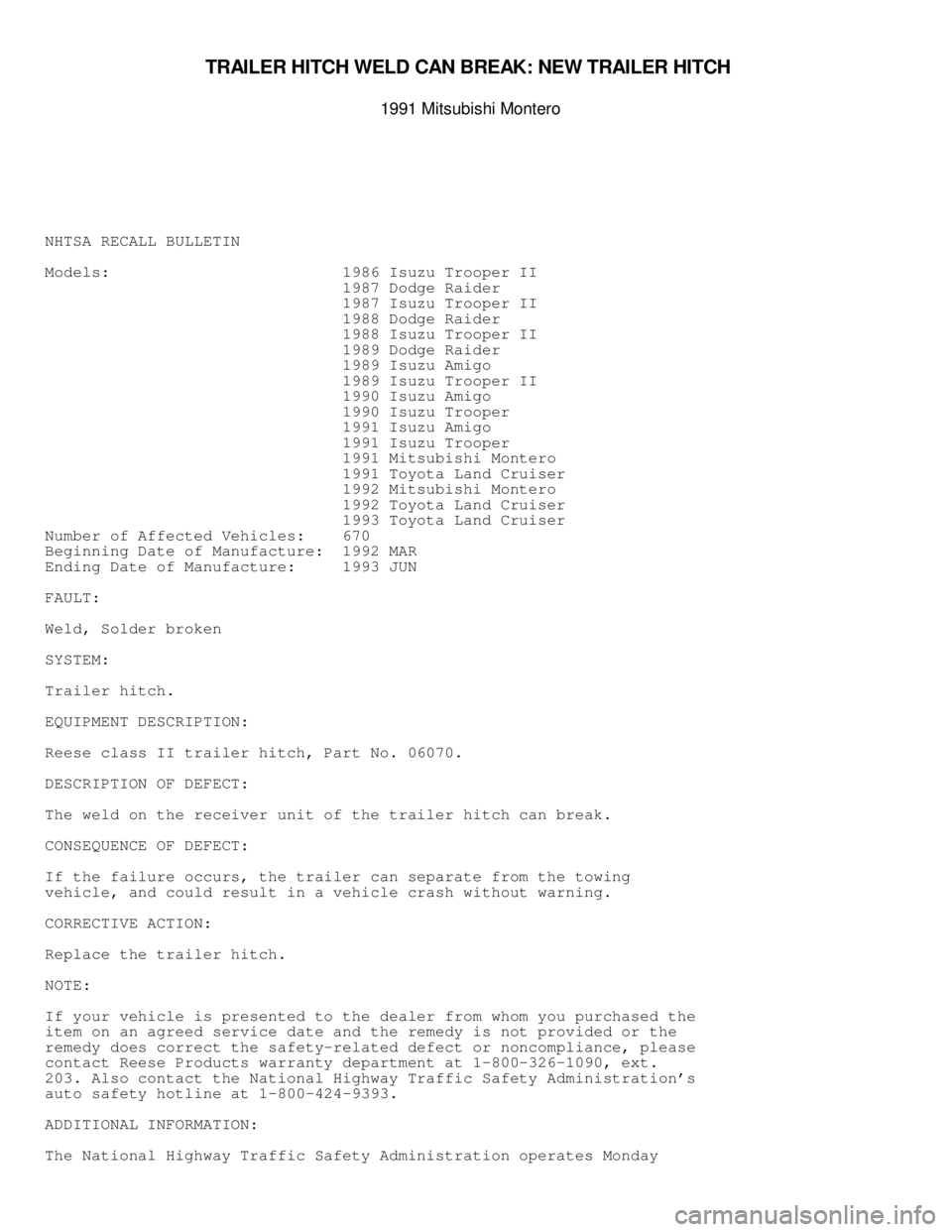
\003
TR AIL E R H IT C H W ELD C AN B REA K : N EW T R AIL E R H IT C H
�
1991 M it s u bis h i M onte ro
NHTSA RECALL BULLETIN
Models: 1986 Isuzu Trooper II
1987 Dodge Raider
1987 Isuzu Trooper II
1988 Dodge Raider
1988 Isuzu Trooper II
1989 Dodge Raider
1989 Isuzu Amigo
1989 Isuzu Trooper II
1990 Isuzu Amigo
1990 Isuzu Trooper
1991 Isuzu Amigo
1991 Isuzu Trooper
1991 Mitsubishi Montero
1991 Toyota Land Cruiser
1992 Mitsubishi Montero
1992 Toyota Land Cruiser
1993 Toyota Land Cruiser
Number of Affected Vehicles: 670
Beginning Date of Manufacture: 1992 MAR
Ending Date of Manufacture: 1993 JUN
FAULT:
Weld, Solder broken
SYSTEM:
Trailer hitch.
EQUIPMENT DESCRIPTION:
Reese class II trailer hitch, Part No. 06070.
DESCRIPTION OF DEFECT:
The weld on the receiver unit of the trailer hitch can break.
CONSEQUENCE OF DEFECT:
If the failure occurs, the trailer can separate from the towing
vehicle, and could result in a vehicle crash without warning.
CORRECTIVE ACTION:
Replace the trailer hitch.
NOTE:
If your vehicle is presented to the dealer from whom you purchased the
item on an agreed service date and the remedy is not provided or the
remedy does correct the safety-related defect or noncompliance, please
contact Reese Products warranty department at 1-800-326-1090, ext.
203. Also contact the National Highway Traffic Safety Administration's
auto safety hotline at 1-800-424-9393.
ADDITIONAL INFORMATION:
The National Highway Traffic Safety Administration operates Monday
Page 1173 of 1333
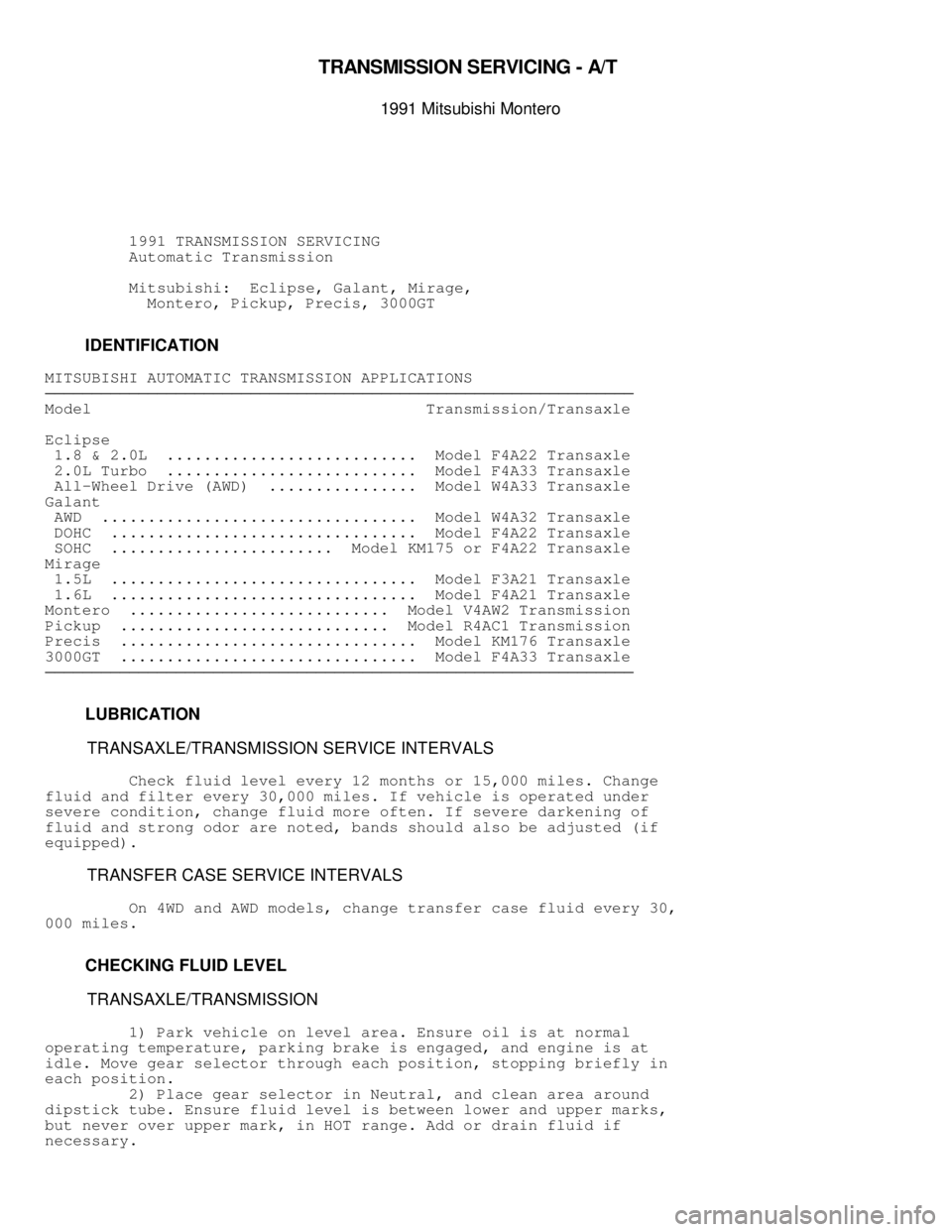
\003
TR AN SM IS SIO N S ER VIC IN G - A /T
�
1991 M it s u bis h i M onte ro
1991 TRANSMISSION SERVICING
Automatic Transmission
Mitsubishi: Eclipse, Galant, Mirage,
Montero, Pickup, Precis, 3000GT
IDENTIFICATION
MITSUBISHI AUTOMATIC TRANSMISSION APPLICATIONS������������������\
������������������\
������������������\
������������������\
������������������\
������������������\
�����������������
Model Transmission/Transaxle
Eclipse
1.8 & 2.0L ........................... Model F4A22 Transaxle
2.0L Turbo ........................... Model F4A33 Transaxle
All-Wheel Drive (AWD) ................ Model W4A33 Transaxle
Galant
AWD .................................. Model W4A32 Transaxle
DOHC ................................. Model F4A22 Transaxle
SOHC ........................ Model KM175 or F4A22 Transaxle
Mirage
1.5L ................................. Model F3A21 Transaxle
1.6L ................................. Model F4A21 Transaxle
Montero ............................ Model V4AW2 Transmission
Pickup ............................. Model R4AC1 Transmission
Precis ................................ Model KM176 Transaxle
3000GT ................................ Model F4A33 Transaxle
������������������\
������������������\
������������������\
������������������\
������������������\
������������������\
�����������������
LUBRICATION
TRANSAXLE/TRANSMISSION SERVICE INTERVALS
Check fluid level every 12 months or 15,000 miles. Change
fluid and filter every 30,000 miles. If vehicle is operated under
severe condition, change fluid more often. If severe darkening of
fluid and strong odor are noted, bands should also be adjusted (if
equipped).
TRANSFER CASE SERVICE INTERVALS
On 4WD and AWD models, change transfer case fluid every 30,
000 miles.
CHECKING FLUID LEVEL
TRANSAXLE/TRANSMISSION
1) Park vehicle on level area. Ensure oil is at normal
operating temperature, parking brake is engaged, and engine is at
idle. Move gear selector through each position, stopping briefly in
each position.
2) Place gear selector in Neutral, and clean area around
dipstick tube. Ensure fluid level is between lower and upper marks,
but never over upper mark, in HOT range. Add or drain fluid if
necessary.